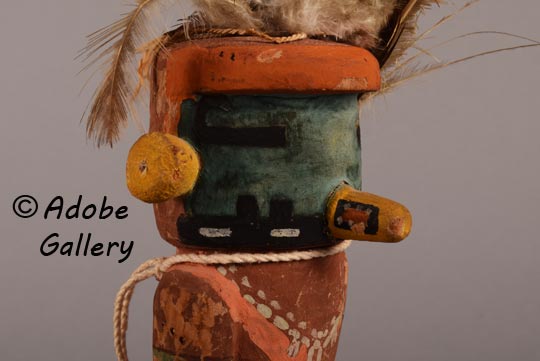Traditional Hopi Pueblo Tasap Katsina Doll, circa 1930s [SOLD]
+ Add to my watchlist Forward to Friend
- Category: Traditional
- Origin: Hopi Pueblo, Hopituh Shi-nu-mu
- Medium: wood, paint, feathers
- Size: 10-¼” tall excluding feathers
- Item # C4775A SOLD
This Tasap Katsina doll is a remarkable carving that showcases the intricate artistry of the 1930s. The doll is primarily a one-piece carving, with additional protrusions added for the snout and ears. The arms are delicately tucked to the body, and the doll features traditional paints, reflecting the artistic conventions of the era.
One of the striking features of this doll is the size of its head. It's important to remember that the katsina head is designed to fit over a human head, necessitating a larger proportion compared to the body. This proportional balance has been beautifully achieved by the carver, demonstrating his mastery and attention to detail.
The body paint of the doll appears to be the mud pigment typically used on the Koyemsi, while the turquoise face is likely a result of mineral pigment application. The overall carving exudes a sense of casualness, a characteristic attribute of pre-1940s carvings, yet it doesn't detract from the doll's extraordinary appeal.
The doll represents the Tasap Katsina, a Hopi interpretation of a Navajo deity. This is a testament to the Hopi tradition of creating versions of katsinam that honor and depict other tribes, such as the Navajo, Havasupai, Comanche, Zuni, among others. This practice underscores the intertribal respect and cultural exchange that enriches the diversity of Native American art and spirituality.
"It has been incorrectly stated that the Tasap Kachina came from the Navajo. It does only in the sense that the Bee Kachina comes from bees. It was never a Navajo dance figure. But it is instead the Hopis' interpretation of their neighbors. He is a very popular kachina. This popularity is the reason for the variety of Tasap Kachinas and is undoubtedly one of the reasons that he may be selected for the Niman Ceremony instead of the Hemis Kachina. Usually, he performs in the plaza as a regular kachina dance (sic). The actual dance is one of rather monotonous stamping that is broken at intervals by some rather interesting turns and calls." [Wright 1973:180]
Condition: good condition with some pigment abrasions, a crack in the kilt on the back side, and a broken and glued foot. The condition represents his age very accurately.
Provenance: this Traditional Hopi Pueblo Tasap Katsina Doll, circa 1930s is from the collection of a collector from California.
Reference: Wright, Barton. Kachinas: a Hopi Artist's Documentary
TAGS: Kachina – Katsina Doll, Hopi Pueblo

- Category: Traditional
- Origin: Hopi Pueblo, Hopituh Shi-nu-mu
- Medium: wood, paint, feathers
- Size: 10-¼” tall excluding feathers
- Item # C4775A SOLD
Adobe Gallery Recommended Reading
Adobe Gallery Recommended Items
If you are interested in this item, we would also like to recommend these other related items:



